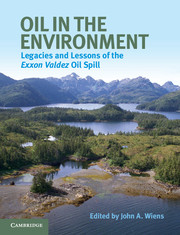Book contents
- Frontmatter
- Contents
- List of contributors
- Use of acronyms
- Acknowledgments
- A bibliographic note
- Prologue
- Part I Introduction and background
- Part II Oil in the environment
- 3 Oil in the water column
- 4 Surveying oil on the shoreline
- 5 Ancient sites and emergency response: cultural resource protection
- 6 Fate of oil on shorelines
- 7 Understanding subsurface contamination using conceptual and mathematical models
- 8 Removal of oil from shorelines: biodegradation and bioremediation
- Part III Biological effects
- Part IV Assessing oil spill effects and ecological recovery
- Part V Conclusions
- Index
- References
5 - Ancient sites and emergency response: cultural resource protection
Published online by Cambridge University Press: 05 July 2013
- Frontmatter
- Contents
- List of contributors
- Use of acronyms
- Acknowledgments
- A bibliographic note
- Prologue
- Part I Introduction and background
- Part II Oil in the environment
- 3 Oil in the water column
- 4 Surveying oil on the shoreline
- 5 Ancient sites and emergency response: cultural resource protection
- 6 Fate of oil on shorelines
- 7 Understanding subsurface contamination using conceptual and mathematical models
- 8 Removal of oil from shorelines: biodegradation and bioremediation
- Part III Biological effects
- Part IV Assessing oil spill effects and ecological recovery
- Part V Conclusions
- Index
- References
Summary
Introduction
For over 4000 years, humans have lived, fished, hunted, and developed industries in Prince William Sound (PWS). When Exxon Valdez oil spilled in 1989, hundreds of archaeological sites and artifacts were potentially at risk. Many were at least superficially known, but most were not. Archaeologists and other cultural resource experts had to move quickly to identify vulnerable sites and work with others engaged in the response to safeguard Alaska’s heritage from oil and incidental harm during cleanup. Exxon created the Exxon Valdez Cultural Resource Program (hereafter the “Program”) to address potential threats to archaeological sites and to comply with state and federal laws.
The 28 archaeologists contracted to Exxon in 1989 coordinated with archaeologists from governmental agencies and Alaska Native organizations to assess the integrity of sites, identify oil concerns, and protect sites from impacts during shoreline cleanup. The archaeological contractors and their agency counterparts were knowledgeable in all areas of cultural-resource management, laws, and the region’s pre- and postcontact history.
- Type
- Chapter
- Information
- Oil in the EnvironmentLegacies and Lessons of the Exxon Valdez Oil Spill, pp. 98 - 115Publisher: Cambridge University PressPrint publication year: 2013



